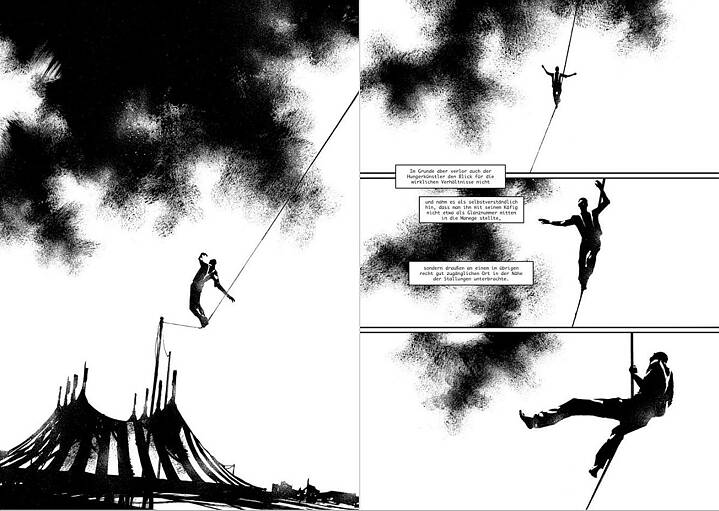Cherrypicker
Wild Kafka mix
In a spectacularly designed graphic novel, the Croatian artist Danijel Žeželj tackles several Franz Kafka novels at once.
By Holger Moos
Right at the beginning of 2024, the year of Kafka – 3 June will mark the centenary of Franz Kafka’s death – avant-verlag published a graphic novel entitled Wie ein Hund (Like a Dog) by the illustrator and comic artist Danijel Žeželj, who divides his time between Zagreb and New York. This is yet another of the fairly numerous cartoon adaptations of Kafka’s life and work that have appeared to date – a selection of which is presented by Ulrich Fügener in Kafka in the realm of comics, his contribution to the Being Kafka edition of our online magazine Zeitgeister. Yet even the cover of Žeželjs graphic novel, which is emblazoned with a classic image of the author sporting a shirt and tie, overcoat and bowler hat, but holding a samurai sword in his hands, leads one to suspect that this is anything but a run-of-the-mill adaptation of Kafka.
The title of Žeželj’s graphic novel is a reference to the final sentence of the novel The Trial, in which two men execute the protagonist K. in his flat: “‘Like a dog!’ he said, it was as if the shame of it must outlive him.”
The plot is based not so much on Kafka’s novel, however, than on his short story A Hunger Artist, though Žeželj has also incorporated elements from other Kafka works – for example from the short stories An Imperial Message, The Truth about Sancho Pansa, The Vulture and The Wish to be a Red Indian, as well as from the Blue Octavo Notebooks.
Greedy for sensation
In Like a Dog, a hunger artist pursues his mission, the general public watching with keen attention. He has planned not to eat anything for 40 days, because, so the impresario believes, it is impossible to keep the audience’s interest alive for any longer. Once the 40 days are up, the hunger artist would actually prefer to continue his art, but – in much the same way that K. is taken to his death by the two gentlemen – two young ladies haul him off to have a meal.Afterwards, the hunger artist lives on, sad and misunderstood, but interest in his art dwindles. The public is greedy for new sensations. So he joins a circus where, in a caged waggon, he plays only a marginal role in circus life yet nonetheless clings obsessively to his art, which proves to be his doom.
Visually overwhelming
Like hallucinations, parallel stories are abruptly woven into the plot, such as the doorkeeper parable from The Trial in which a man waits in vain outside a huge gate to gain entry to the law, or the capturing of a town by archaic hordes of warriors (from the second Blue Octavo Notebook).Žeželj provides a visually overwhelming backdrop to this wild mixture of texts. Rugged, morbid, bleak and sinister are adjectives that come to mind when one looks at the black-and-white images. From afar, this retrofuturistic graphic novel is reminiscent of expressionistic silent films, the science fiction classic Blade Runner or indeed Batman’s Gotham City. The page layout is very varied, with some panels filling entire pages while another page might feature several horizontal or vertical panels, either next to or below one another. There are long shots that depict cityscapes, a staircase reminiscent of a Maya temple that leads up to the gate of the law, crowds of people or circus scenes, yet images are often zoomed in, with the result that a panel shows only a face or eyes.
In Žeželj’s fascinating graphic novel, the conventional laws of logic do not apply and a quote from Kafka’s third Blue Octavo Notebook best sums things up: “What is ridiculous in the physical world is possible in the spiritual world.”
Danijel Žeželj: Wie ein Hund
Berlin: avant-verlag, 2024. 104 S.
ISBN: 978-3-96445-119-4





